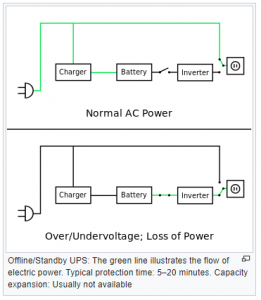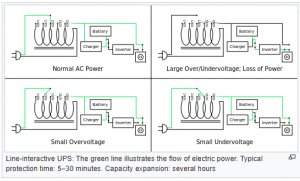Protecting your essential equipment with a UPS
An Uninterruptible Power Supply (UPS) provides emergency power when the power source or mains power fails. A UPS differs from an emergency power system or standby generator in that it provides near instantaneous protection from power interruptions by supplying energy stored in batteries, supercapacitors or flywheels. The on-battery run time of most UPS is generally short (minutes rather than hours) but is sufficient to start a standby power source or properly shut down the equipment.
A UPS is designed to protect your vulnerable, and often expensive hardware from physical or memory-based damage if they’re suddenly disconnected from mains power. UPS’ are typically used to protect hardware such as computers, data centres, telecommunication equipment or other essential electrical equipment such as emergency lighting or alarm systems.
While a UPS’ main role is to provide short-term power when there is a power failure, most UPS units can also, in varying degrees, correct common utility power problems such as voltage spikes, sustained over voltage or momentary or sustained reduction in input voltage
What size UPS do I need?
Any UPS you install must be large enough to support all the equipment plugged into it. This means you need to calculate the load required. The load is the total amount of power drawn in watts of all the devices that are or will be plugged into the UPS. Once you know the load, you can select a UPS with the right capacity for your needs. The capacity is how much power a UPS can provide (measured in watts) if needed.
The runtime required in the event of power outage will also determine the size UPS you need. Runtime is the number of minutes a UPS can support the attached devices during a blackout.
The minimum runtime should be the time needed to complete proper equipment shutdown.
The smaller the wattage load connected to the UPS the longer the batteries will last. To determine the runtime you need, start with the number of minutes required to completely shut down the connected devices. If a long runtime is required you can upsize your UPS so the connected load is a smaller percentage of the capacity or, with some UPS units, you have the ability to add additional battery modules to extend runtime.
Different types of UPS
- A Standby UPS is an offline unit that can detect a mains power failure and switch to battery power automatically. In normal operation the load is fed directly by mains power.

- A Line-interactive UPS conditions the mains power by regulating input voltage up or down in a buck-boost transfer, before allowing it to pass through to your protected equipment. In the event of a mains power failure, battery power is provided automatically.

- An on-line UPS converts power tiwce. First an input rectifier converts AC power into DC and feeds it to an output inverter. The output inverter then converts the power back to AC before sending it on to the protected equipment. This double conversion process insulates critical loads from dirty mains power completely to ensure that the connect equipment receives only clean reliable electricity.

UPS Maintenance
UPS’ should be regularly maintained to ensure that they are ready to function when you need them. Investing in a planned maintenance programme for your UPS can improve both reliability and the overall lifespan of your system. A well maintained and regularly serviced UPS needs less power to run, as well as being far less likely to fail and cause critical downtimes.
Preventative Maintenance Checks for your UPS:
- Internal and external checks
- Calibration of all metering and protective features if required
- Functional testing of all transfer conditions
- Inspection of on-line performance of equipment with load
- Visual check of batteries and battery environment
- Testing of battery voltage.
The EAS are highly skilled in sizing, installing and maintaining UPS’. If you would like to discuss protecting your essential equipment with a UPS get in touch with the EAS team today on 07 834 0505 or [email protected].

Leave a Reply
Want to join the discussion?Feel free to contribute!